Don't wanna be here? Send us removal request.
Text
Trading as a Side Hustle: How to Balance with a Full-Time Job ?

Many working professionals want to grow a second source of income — without quitting their jobs. One of the smartest ways to do this is through part-time trading.
Whether you’re in IT, sales, education, or any 9–5 role, trading can become a rewarding side hustle — if done the right way.
Why Trading Is a Smart Side Hustle.
• Low startup cost (₹1000–₹5000 is enough to begin) • Flexible — no fixed hours or boss • Scalable with time & experience • Works from your phone/laptop, anytime, anywhere
But remember — without proper education and planning, trading can also lead to losses.
How to Balance Trading with a Full-Time Job.
1. Build a Routine
• Mornings (8:30–9:15 AM): Check news, prepare watchlist • During Breaks: Track alerts, avoid fresh trades • Evenings (6–9 PM): Chart analysis, trade review, learning
2. Pick the Right Trading Style
Intraday Trading
Time Needed: High
Suitable For: Full-time traders
Swing Trading
Time Needed: Medium
Suitable For: Working professionals
Positional Trading
Time Needed: Low
Suitable For: Busy individuals
Swing and positional trading are best for side hustlers.
3. Use the Right Tools
• Broker Apps – Zerodha, Upstox • Charting – TradingView, Chartink • Alert Systems – Price/indicator-based alerts • Journaling – Google Sheets or Notion
Let tech do the heavy lifting while you focus on strategy.
Challenges Faced by Part-Time Traders.
• Limited screen time • Missed trade opportunities • Emotional trading after work hours • Making hasty decisions without analysis
That’s why planning and discipline are critical.
Smart Strategies for Side Hustle Trading.
Keep Capital Small Initially Start with ₹2000–₹5000 and focus on learning, not profits.
Trade Less, Think More One high-conviction trade a week is better than daily random trades.
Risk Management Is King Never risk more than 1–2% of your capital per trade.
Use Alerts & Stop Losses Set entry/exit triggers so you’re not glued to the screen.
Journal Your Trades Track your wins, losses, and learnings weekly.
Final Thoughts from Traders Training Academy.
Balancing your job with trading isn’t about multitasking — it’s about systematic effort, clear strategies, and long-term discipline.
At Traders Training Academy, we help working professionals become confident part-time traders with: 1. Step-by-Step Strategy Building 2. Technical + Fundamental Learning 3. Real-Market Simulations 4. Risk & Psychology Training.
0 notes
Text
Geopolitical Events : Trading During Uncertainity.

What Are Geopolitical Events ?
Geopolitical events include any global or regional political, military, or diplomatic incident that has the power to influence economies and investor sentiment. Examples include:
Russia-Ukraine War
U.S.–China trade disputes
Brexit negotiations
Middle East conflicts
National elections in major economies
These events create volatility, shift market trends, and often trigger emotional trading behaviors.
How Do They Impact the Markets?
Geopolitical events typically impact:
1. Stock Markets
Fall in equity prices due to fear and panic selling.
Defensive stocks (like FMCG, pharma) may outperform.
High beta sectors (like finance, infra) usually underperform.
2. Commodity Markets
Gold & Silver: Surge as safe-haven assets .
Crude Oil: Rises if there are supply chain disruptions.
3. Currency Markets
Safe currencies like USD, CHF, or JPY often strengthen.
Risk-sensitive currencies (like emerging markets) weaken.
4. Bond Markets
Investors move to government bonds → yields fall.
Central banks might tweak interest rates for economic support.
Challenges for Traders.
Trading during uncertain times can be tricky due to:
High volatility
Unexpected news flow (overnight changes)
False breakouts in technical patterns
Tight stop losses getting hit frequently
Strategies to Trade Smartly During Geopolitical Events
1. Stay Updated
Use reliable news sources like Bloomberg, Reuters, Economic Times, etc. Avoid WhatsApp forwards and rumors.
2. Use Safe-Haven Assets
Gold ETFs, sovereign bonds, and defensive stocks can protect your portfolio.
3. Avoid Overleveraging
Reduce position size during volatile periods. Protect your capital first!
4. Prefer Short-Term Trading
Instead of long-term bets, go for intraday or swing trades with strict SLs.
5. Follow the VIX (Volatility Index)
High VIX = high fear = trade cautiously. Low VIX = stable markets = go aggressive (with proper setups).
6. Use Hedging Techniques
Use options or inverse ETFs to hedge your portfolio.
Real Example: Russia-Ukraine War
Global markets fell sharply in Feb 2022
Crude oil went above $130/barrel
Indian stock market corrected 7–10% in 2 weeks
Gold and USD gained heavily
Smart traders booked profits by shorting Nifty and buying gold ETFs
Final Thoughts from Traders Training Academy
Geopolitical uncertainty isn’t something you can control—but your reaction to it is in your hands.
At Traders Training Academy, we teach traders how to stay calm, analyze macroeconomic conditions, and use smart trading setups to benefit even during high-stress times.
“Uncertainty is where the smart money is made—if you know the game.”
Stay Ahead with Traders Training Academy
Join our Live Trading Sessions Master Technical Fundamental Analysis Learn Risk Management Like a Pro
0 notes
Text
How Interest Rate Hikes Shape Trader Sentiment ?
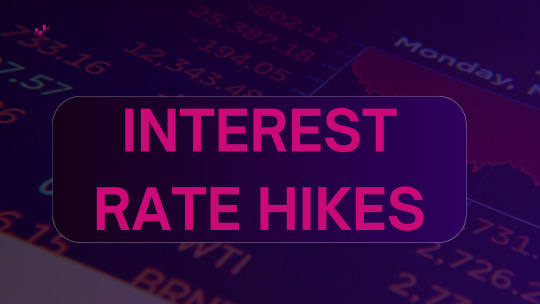
How Interest Rate Hikes Shape Trader Sentiment ?
What Are Interest Rates?
Interest rates refer to the cost of borrowing money. Central banks like the Reserve Bank of India (RBI) or the US Federal Reserve adjust interest rates to control inflation, stimulate or slow down economic growth, and stabilize the financial system.
An interest rate hike means the central bank is increasing this borrowing cost. This action ripples across all financial markets—and affects how traders think and react.
How Interest Rate Hikes Affect Trader Sentiment
When rates go up, borrowing becomes expensive. Consumers spend less, companies cut back on investments, and economic activity slows down. But for traders, interest rate hikes signal deeper shifts:
Stock Market Impact
Higher interest rates mean higher loan costs for companies → lower profits.
Growth stocks, especially in sectors like tech or real estate, come under pressure.
Traders shift focus to defensive sectors like FMCG, pharma, and utilities that tend to remain stable during uncertain periods.
Investor Sentiment Shift
Interest rate hikes create a “risk-off” environment.
Traders and investors exit risky assets like crypto, penny stocks, or small-cap companies.
They move toward safe-haven assets such as gold, bonds, or large-cap stocks with strong fundamentals.
This sudden shift in capital can lead to high volatility and short-term price drops.
Currency Market Response
A country with higher interest rates attracts foreign investors looking for better returns.
This increases demand for that country’s currency (like USD or INR), causing it to strengthen.
Forex traders adjust their positions quickly, often riding these currency movements.
Volatility & Panic Moves
Retail traders often react emotionally.
Panic selling or over-buying during interest rate news can cause market overreactions.
This results in spikes in volatility, especially in index-based instruments like Nifty, Sensex, S&P500, etc.
Real Example
During the US Fed rate hikes in 2022–2023, the following happened:
Nasdaq corrected significantly as investors pulled out of growth stocks.
Gold rallied as a safe haven.
The US Dollar strengthened massively in the global forex markets.
ETF outflows caused added pressure on indices and fund-heavy stocks.
This shows how rate hikes shape not just prices, but trading psychology.
Pros of Understanding Rate Hikes
Better market timing
Smarter asset allocation
Reduced emotional trading
Early detection of sector rotation
Risks of Ignoring It
Sudden losses due to volatility
Wrong entries or exits
Following false breakouts or reversals
Missing out on bigger macro trends
Final Thoughts
Interest rate hikes are not just economic events. They are powerful market signals that influence everything from stocks and currencies to trader behavior and sentiment.
To become a smart trader, you must learn how to interpret macroeconomic data, including interest rates, inflation, and global cues.
Want to Learn More?
Join Traders Training Academy to master concepts like:
Interest rates
Inflation vs. market moves
Trading strategies for macro events
Risk control and mindset during volatile times
0 notes
Text
ETFs and How They Affect Market Movements

ETFs and How They Affect Market Movements
What are ETFs?
ETFs (Exchange-Traded Funds) are investment funds that are traded on stock exchanges—just like individual stocks. These funds hold a collection of assets such as stocks, bonds, commodities, or even currencies. Investors buy shares of ETFs to get exposure to the overall performance of a sector, market index, or strategy.
For example, Nifty 50 ETF tracks the Nifty 50 index. So when you invest in that ETF, you’re indirectly investing in all 50 companies in the index.
How Do ETFs Work?
ETFs are created by large institutions called Authorized Participants who buy a basket of assets and form ETF units.
These units are then listed on the stock exchange and traded like any other stock.
The price of an ETF changes throughout the day based on demand and supply—unlike mutual funds, which are priced once a day.
How ETFs Affect Market Movements
1. Market Liquidity
ETFs increase liquidity in the market. Since ETFs are traded actively, they help maintain high buying and selling activity even during volatile periods.
2. Sector Movements
If large investors buy or sell ETFs focused on certain sectors (like banking or IT), it can impact the prices of all the underlying stocks, causing sector-wide rallies or declines.
3. Price Discovery
ETFs often mirror market sentiment. So sudden ETF inflows or outflows can act as early signals of price movements or trend reversals in the market.
4. Volatility Impact
While ETFs provide diversification, massive movements in ETFs—especially during panic selling—can amplify volatility across the board.
Real Example
During COVID-19 market crash (March 2020), many investors pulled money out of equity ETFs. This led to heavy selling in the index constituents—causing sharp declines in Nifty and Sensex. Later, when markets recovered, ETF inflows played a big role in the bounce-back.
Pros of ETFs
Easy diversification
Low expense ratio
Real-time trading flexibility
Transparent holdings
Cons of ETFs
Can create sudden volatility
Tracking error risk
Sector-specific ETFs may have concentration risk
Final Thoughts
ETFs are powerful tools for both retail and institutional investors. But they’re not just passive instruments—they have real influence on stock prices, index movements, and even overall market sentiment.
Want to learn more about market tools like ETFs, futures, and options? Join Traders Training Academy and get ahead in your trading journey.
0 notes
Text
IPO Frenzy : How to Analyze and Trade New Listings.
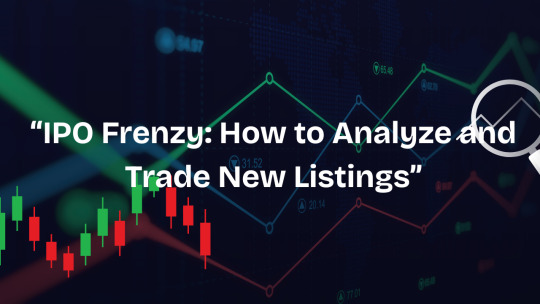
In recent years, IPOs (Initial Public Offerings) have become one of the hottest opportunities for traders and investors. Everyone wants to catch the next Zomato, Nykaa, or Mamaearth at the right price — but not all IPOs are worth the hype.
In today’s blog, let’s break down how to analyze and trade IPOs the smart way.
What is an IPO?
An IPO is when a private company goes public by offering its shares to the general public for the first time. It's a way for the company to raise funds and give early investors an exit.
Why IPOs Create a Frenzy
Media Hype & Social Media Buzz
Limited Allotment – Creates a sense of scarcity
Big Listing Gains – Many IPOs debut with 20-50% premium
FOMO – Fear of Missing Out drives demand
How to Analyze an IPO Before Investing
1. Company Fundamentals
Understand the business model
Check revenue, profit trends, and margins
Look at industry positioning and future growth potential
2. Promoter Background
Who is running the company?
Track record of promoters and key management
3. Use of Funds
Where will the IPO money go?
Red flag if it’s just for debt repayment or exit by private investors
4. Valuation
Compare valuation (P/E, P/BV) with listed peers
Don’t overpay for hype
5. Anchor Investors
Strong anchor book = Good confidence from institutional players
Listing Day Strategy: Trade or Hold?
1. For Listing Gains
Apply only in good quality IPOs with grey market premium (GMP) support
Exit on listing day if overvalued or unsure about long-term story
2. For Long-Term Investors
Hold only if company has strong fundamentals
Buy more after consolidation post-listing
3. For Traders
Watch listing price action
Use tight stop loss if trading on momentum
Real Examples
Zomato (2021): Strong listing, surged post IPO — but gave better entry after correction
Paytm (2021): Overvalued and crashed after listing — cautionary tale
Tata Tech (2023): Solid fundamentals + brand trust = multi-fold gains
Pro Tips
Always read the DRHP (Draft Red Herring Prospectus)
Don’t chase every IPO — quality over quantity
Don’t fall for GMP alone — it's just sentiment, not guarantee
Wait for post-listing price stabilization for better entries
Final Thoughts
IPO trading can be rewarding, but it requires discipline and research. Don’t get carried away by the noise. Focus on the business, valuations, and long-term potential. Remember — even the best companies can be bad IPO investments if the price isn’t right. Ready to Level Up Your Trading Skills?
Join Traders Training Academy – where beginners become confident traders. Get access to expert-led sessions, real-time market insights, and practical strategies that actually work.
Start your journey today – because smart trading begins with smart learning.
0 notes
Text
Decoding Budget Announcements for Traders.

The Union Budget is not just a political or economic event—it's a market-moving announcement that traders eagerly await each year. Budget speeches often bring volatility, opportunities, and sudden trend reversals in the stock market. But how can a trader make the most of it ?
In this blog, we decode how traders should interpret budget announcements and turn them into actionable strategies.
Why Budget Matters for Traders.
The Budget outlines:
Tax policies.
Sectoral allocations.
Government borrowing.
Inflation outlook.
Investment incentives.
These elements affect market sentiment, sector performance, and macro-economic indicators, which directly influence stock prices.
Key Budget Elements to Track as a Trader
1. Fiscal Deficit and Government Spending
A lower fiscal deficit often boosts market confidence.
Increased capital expenditure (infra, roads, railways) is bullish for infra and cement stocks.
2. Sector-Wise Allocations
Budget announcements with increased funding or tax cuts in specific sectors (e.g. EVs, renewable energy, defense) often trigger rallies in those sectoral stocks.
3. Tax Slabs and Personal Income Policies
Changes in tax slabs impact consumer spending, affecting sectors like FMCG, auto, and real estate.
4. Capital Market Reforms
Any new rules or incentives for investors or traders (like changes in LTCG, STT, or tax on derivatives) directly affect market participation.
How to Trade Around Budget Announcements
Before the Budget (Pre-Budget Rally)
Market often anticipates good news—buying on expectation is common.
Focus on sectors in the limelight (infra, PSU banks, renewable energy, etc.).
On Budget Day
High volatility! Avoid large positions unless you're experienced.
Prefer option strategies like straddles or strangles for neutral views.
Post Budget
Watch for sector rotation.
Focus on delivery-based trades in newly favored sectors.
Use technical confirmations before entries.
Real Examples (Previous Budgets)
2023 Budget: Focus on capex and no change in LTCG → Nifty rallied over 1.5% post-announcement.
2024 Budget: Stocks like Adani Ports, Reliance, BHEL, and Tata Power saw buying interest.
Pro Tips for Budget Season Trading
Stay updated with live news feeds on Budget Day.
Always set SL (Stop Loss)—volatility can trap both bulls and bears.
Use sectoral ETFs if unsure about stock selection.
Keep your emotions in check; trade based on strategy, not hype.
Final Words
The Budget is a goldmine of opportunities for traders who can decode it smartly. Understand the implications, track the market reaction, and trade with a strategy.
Want to learn budget-based trading strategies in detail ? Join our expert-led training at Traders Training Academy.
0 notes
Text
Creating a Personal Trading Manifesto: Your Guide to Consistent and Disciplined Trading
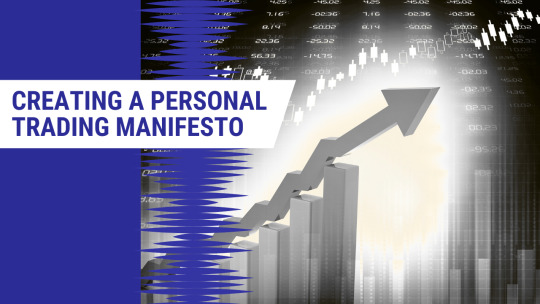
In the world of trading, emotions, impulsive decisions, and inconsistency can be your biggest enemies. That’s where a Personal Trading Manifesto comes in — a written declaration of your trading beliefs, rules, and mindset. It becomes your compass, keeping you on track even when the markets get tough. In this blog, we'll help you create your own trading manifesto and explain why every serious trader needs one.
What is a Trading Manifesto?
A trading manifesto is a personal document that outlines your:
Core trading beliefs.
Rules and strategies.
Risk management principles.
Mindset and goals.
Think of it as your trading constitution — a set of non-negotiable principles that help you trade with clarity and discipline.
🧭 Why You Need One
Here’s how a trading manifesto can benefit you:
1. Prevents Emotional Trading. 2. Creates Discipline. 3. Improves Consistency. 4. Helps with Review and Growth.
How to Write Your Personal Trading Manifesto.
1. Define Your Trading Purpose – Why You Trade and What You Aim to Achieve
Helps you stay aligned with your long-term goals and avoid random decisions.
2. Clarify Your Trading Beliefs – What You Think About Market, Risk, and Psychology
Establishes your mindset and principles that guide your trading behavior. 3. Document Your Trading Strategy – What Setup, Timeframe, and Tools You Follow.
Keeps your approach consistent and prevents impulsive or random trades.
4. Set Risk Management Rules – Define Capital Risk, Trade Limits, and Stop Conditions
Protects your capital and avoids overtrading or major drawdowns.
5. Establish Mindset Rules – How You Will Handle Emotions, Wins, and Losses
Helps maintain discipline, control impulses, and stay emotionally balanced.
Final Thoughts
Creating a personal trading manifesto is like creating a mirror — it reflects your best self as a trader. It won’t guarantee profits, but it will protect you from your worst trading habits.
Start writing your manifesto today. Keep it near your desk. Read it every morning before you start trading.
Ready to Take Control of Your Trading?
Join Traders Training Academy and learn how to trade like a pro. Our programs help you build consistency, discipline, and the right mindset for long-term success.
0 notes
Text
How to Handle FOMO (Fear of Missing Out) in Trading.

Introduction . FOMO — the “Fear of Missing Out” — is one of the most powerful emotional traps in trading. Whether it’s seeing others make big profits or watching a stock skyrocket after you hesitated, FOMO can push you into impulsive decisions that sabotage your success. In this blog, we’ll explore what FOMO really is, how it affects traders, and proven ways to control it so you can trade with confidence and clarity.
What is FOMO in Trading.?
FOMO is the anxious feeling that you're missing a big opportunity. In trading, it shows up when:
You chase a stock after it already made a big move.
You enter a trade without a setup because "everyone else is buying".
You break your risk rules because you're afraid to miss out.
FOMO is emotional — not strategic. And when you act out of emotion, you’re not trading — you’re gambling.
Why FOMO is Dangerous
1. Poor Entry Points.
Traders driven by FOMO often enter late — right when a stock is peaking. This increases the chance of a loss as the price starts correcting.
2. Overleveraging.
To make up for "missed profits," FOMO traders may increase their position size and risk more — leading to bigger losses.
3. Emotional Burnout.
Constant stress, regret, and chasing the market exhaust your mind, making it harder to stick to a strategy.
4. Inconsistent Trading.
FOMO makes you jump from one stock, setup, or strategy to another — killing consistency and discipline.
How to Handle FOMO in Trading (Step-by-Step)
1. Accept That You’ll Miss Some Trades.
You don’t have to catch every opportunity to be successful. The market will always offer new setups. Missing one trade doesn't mean you've failed.
2. Stick to a Defined Trading Plan.
If a trade doesn’t meet your criteria — skip it. Your edge lies in following a tested plan, not in reacting emotionally.
3. Practice the “Next Trade Mindset”.
Train yourself to say, “If I miss this one, no problem — I’ll get the next.” This mindset shifts your focus from chasing to patience.
4. Limit Your Screen Time.
Constantly watching charts or social media increases anxiety. Take breaks. Check the market only during pre-decided times.
5. Journal Your Trades and Emotions.
Track every FOMO trade. Over time, you’ll see how emotional trades usually end in losses — this awareness helps you pause before repeating it.
6. Use Risk Management as a Shield.
Even if you do take an impulsive trade, a strict stop-loss and position size will protect your capital.
Final Thoughts.
FOMO isn’t something to "get rid of" — it’s something to manage. Even pro traders feel it — the difference is, they don’t act on it. Train your mind to wait for quality setups, respect your strategy, and stay focused on the long game.
At Traders Training Academy, we don’t just teach strategies — we build emotionally disciplined traders who are immune to FOMO and driven by data, not dopamine.
Ready to master trading psychology? Start your journey with us today.
0 notes
Text
Developing a Winning Trader’s Mindset.
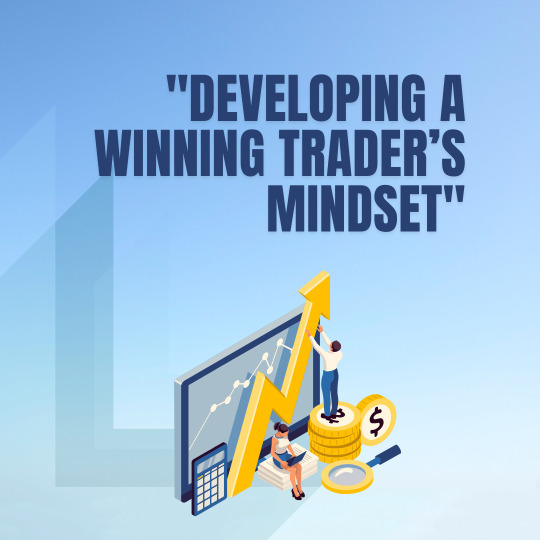
Success in the stock market is not just about technical analysis or chart patterns — it's also about having the right mindset. Most traders fail not because of their strategy, but because they lack the emotional discipline and psychological strength to stick to it.
In this blog, we will uncover the essential traits that define a winning trader’s mindset and how you can build one to thrive in the market.
1. Detach from Money
A professional trader doesn’t trade with emotional attachment to money. If you’re constantly worried about losses or obsessed with profits, you're making emotionally driven decisions — a major reason behind poor trades.
Action Tip: Start thinking in percentages and probabilities, not rupees. Focus on executing your strategy consistently rather than chasing profits.
2. Master Patience and Discipline
The market rewards discipline, not speed. Many beginners overtrade or jump in without confirmation signals. Winning traders wait for high-probability setups and accept when it's best to stay on the sidelines.
Discipline helps avoid revenge trading and emotional decisions after a loss.
3. Accept Losses Like a Pro
Even the best traders lose — often. The difference is they don’t panic, blame the market, or give up. Instead, they learn from every loss, treat it as data, and move forward.
"A losing trade does not mean you’re a losing trader."
4. Stick to a Trading Plan
A winning mindset includes trusting your system. Without a defined plan — entries, exits, risk management — you’re gambling, not trading. Your strategy should be tested, written down, and followed without exception.
5. Continuous Learning
The markets evolve — and so should you. Top traders invest time in learning from books, courses, and mentors. They review their trades weekly, adapt to new conditions, and never believe they know it all.
Final Thoughts
"A winning mindset is the result of commitment, growth, and purpose-driven action."
If you're serious about mastering your trading psychology, visit Traders Training Academy to begin your transformation.
#investing#stock market#tradersmindset#StockMarketEducation#LearnTrading#TradersLife#StockMarketNews
0 notes
Text
The Psychology Behind Losing Streaks and How to Recover.
Every trader — whether a beginner or seasoned pro — eventually faces a losing streak. It’s not just about the numbers or the charts. What truly tests a trader is how they think, feel, and react during these difficult phases. Understanding the psychology behind losing streaks is key to bouncing back stronger.
Why Losing Streaks Happen
1. Market Volatility
Markets are inherently unpredictable. Even solid strategies can fail in the face of sudden news, global events, or unexpected trends.
2. Overconfidence
After a series of wins, traders may take larger risks or ignore their strategy. This shift in behavior often leads to losses.
3. Emotional Trading
Fear, greed, and frustration can cloud judgment. One bad trade can snowball into several poor decisions if emotions take control.
4. Lack of Discipline
Skipping stop-losses, overtrading, or chasing losses are common during losing streaks. These actions push traders further into losses.
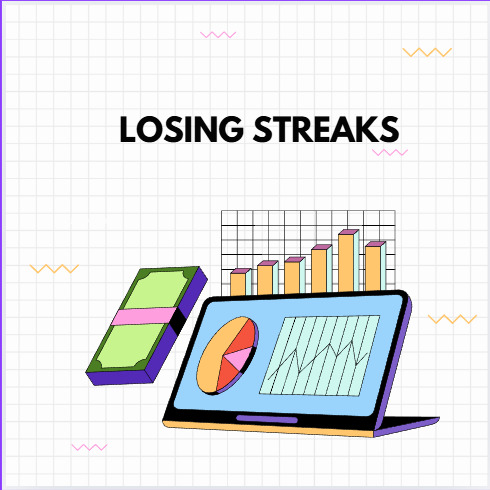
The Mental Impact of Losing Streaks
A losing streak doesn't just hurt your account; it hits your confidence.
Self-Doubt: Traders start questioning their ability and strategy.
Fear of Pulling the Trigger: Even good setups feel risky.
Revenge Trading: Trying to “win it back” quickly often worsens the situation.
At Traders Training Academy, this is one of the most discussed challenges among new and intermediate traders. Losing streaks are seen not as failures but as a natural part of the learning curve — if approached correctly.
How to Recover From a Losing Streak
1. Pause and Reflect
Stop trading temporarily. Review your trades objectively. Was it the market or your decisions? This break allows clarity.
2. Review Your Trading Journal
Track patterns. Are you consistently making the same mistake? Are you breaking your own rules?
3. Rebuild Confidence with Small Wins
Start small again. Use reduced position sizes. Focus on executing your strategy correctly rather than chasing profits.
At Traders Training Academy, one recommended method is to trade on a demo or paper account for a short time. This helps restore discipline and confidence without risking capital.
4. Focus on Process, Not Profits
Shift your mindset. A good trade isn’t one that makes money — it’s one that follows your plan.
5. Seek Support or Mentorship
You’re not alone. Connecting with fellow traders or getting guidance from mentors can accelerate recovery. Structured support — like that provided in the community and programs at Traders Training Academy — can give you the clarity and tools to bounce back faster.
6. Practice Mental Conditioning
Mental strength is crucial. Simple practices like deep breathing, journaling, or visualization can help maintain emotional control.
Preventing Future Streaks
While you can't avoid all losses, you can control how much you lose and how you react:
Use strict risk management (e.g., never risk more than 1-2% of your capital per trade).
Stick to your trading plan, even during uncertainty.
Embrace losses as part of the journey and learn from them.
Courses at Traders Training Academy often emphasize building emotional intelligence along with technical skills — because mastering your mindset is just as important as mastering the market.
0 notes
Text
Entry and Exit Strategies: Finding the Right Timing in the Stock Market
Success in the stock market doesn’t come from just picking the right stock — it comes from entering and exiting at the right time. Even the best stock can turn into a losing trade if your timing is wrong.
In this blog, we’ll explore how traders can build effective entry and exit strategies, and why timing plays a vital role in maximizing profits and minimizing losses.
🔹 Why Entry Timing Matters
Buying too early or too late can make a big difference in your returns.
Key Entry Techniques:
Breakout Entries – Entering when a stock breaks above a resistance level.
Pullback Entries – Buying when the price dips during an uptrend.
Volume Confirmation – Higher-than-average volume can signal strong interest and support your entry decision.
🔻 Exit Strategy: When to Book Profits (or Cut Losses)
Exiting too early may mean leaving profits on the table. Exiting too late might mean giving everything back.
Smart Exit Techniques:
Target Price Exit – Set a clear profit target using technical indicators or past price action.
Trailing Stop-Loss – Lock in gains while letting your winner run.
Support Break Exit – Exit if the price breaks a major support level.
📊 Real-Life Example
Let’s say you bought a stock on a pullback to the 50-day moving average, and it began rising again. A smart exit could be at the next resistance level, or use a trailing stop-loss as it climbs.
Understanding these moves doesn’t just come from theory — it comes from learning through live market examples and mentorship.
🎓 Want to Learn the Exact Techniques in Depth?
If you're serious about mastering entry and exit strategies, you need structured learning. That’s where Traders Training Academy comes in.
We break down:
Real-time chart analysis
Entry timing based on technical indicators
Smart exit planning with real trade examples
0 notes